Amazon Warehousing and Distribution (AWD): Your Guide to Reducing Storage Costs
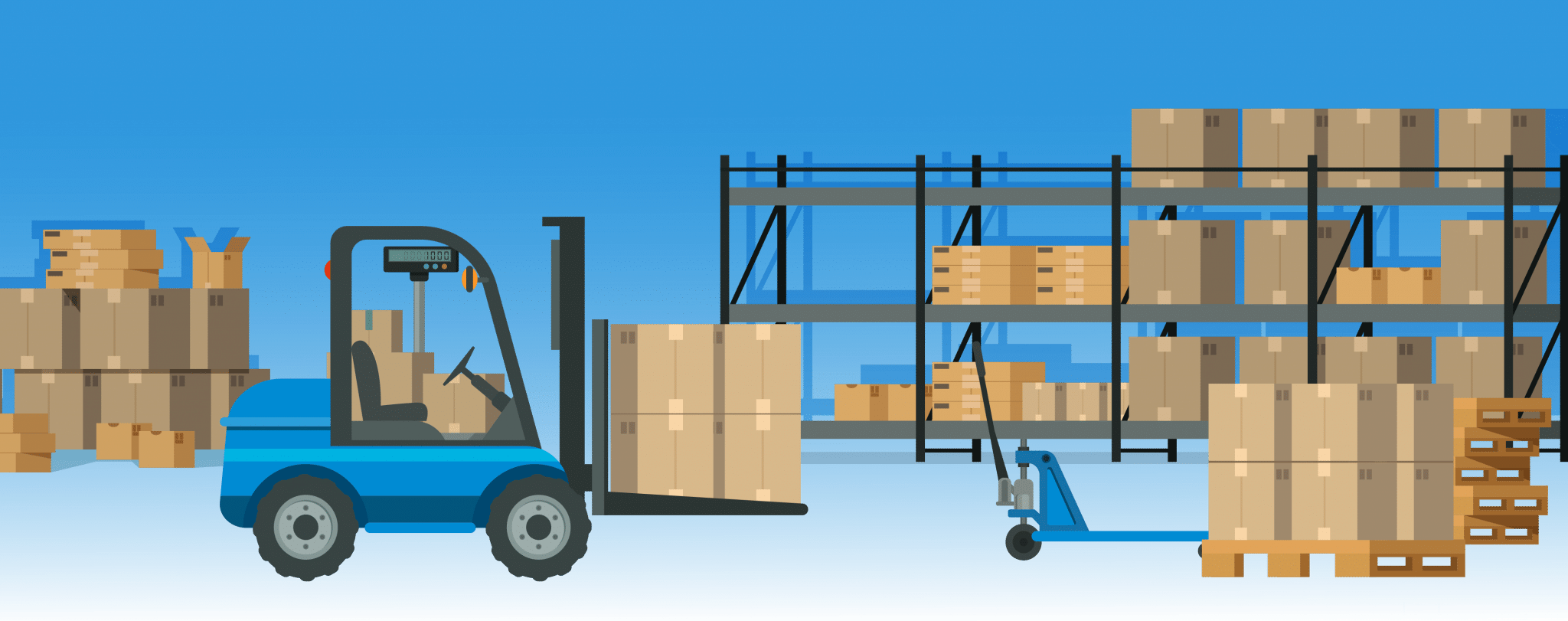
Amazon built a lot of warehouses during the pandemic. However, after the lockdowns were over and people went back to shopping in brick-and-mortar stores, Amazon had to cancel, close, or sublease some of these warehouses because of e-commerce slowdown.
In 2022, the Amazon Warehousing and Distribution (AWD) program was introduced to utilize these infrastructures and give a cheaper long-term storage option for its sellers.
What Is Amazon Warehousing & Distribution Service (AWD) and How Does It Work?
Amazon Warehousing & Distribution (AWD) is a pay-as-you-go service that offers sellers low-cost, long-term storage. In essence, Amazon will store your inventory in their warehouses as they await to be delivered to fulfillment centers.
Here’s how Amazon AWD works:
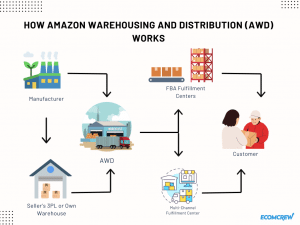
Sellers send in their inventory to AWD warehouses either from their own 3PLs or directly from their manufacturers through Amazon Global Logistics. The inventory is stored in the warehouses until they are ready for shipment to FBA fulfillment centers (for FBA sellers) and to Amazon’s Multi-Channel Fulfillment Centers (for non-FBA sellers). The orders are then sent through the network until they reach customers.
AWD is especially useful to FBA sellers because the system automatically replenishes your stocks in the appropriate fulfillment center so you never run out of inventory.
How Do You Sign Up for AWD?
You can sign up to AWD by
- Going to the program page directly or
- Logging in to Seller Central, and clicking on the following: Seller Central at Growth → Explore Programs → Warehousing and Distribution → Enroll
Do take note that there are certain AWD eligibility requirements you need to meet before you can enroll.
AWD Product Eligibility
There are products that are not eligible for AWD. So if you sell any of these, you can’t send them to AWD warehouses:
- Amazon devices
- Gift cards
- Grocery
- High-value products
- Jewelry
- Shoes
- Watches
- Apparel
- Perishables and products with expiration dates
- Dangerous goods
- Hazardous materials
Some products need to meet FBA requirements such as barcodes and specifics for those in the restricted product categories.
In addition, AWD has size requirements. Only the following are allowed:
| Allowed Sizes | Specifications |
|---|---|
| Conveyable boxes | Maximum dimensions: 25 inches (on any side) Maximum weight: 50 lbs |
| Standard-size ASINs | Maximum dimensions: 18 inches long x 14 inches wide x 8 inches high Maximum weight: 20 lbs |
AWD Seller Eligibility
In order to be eligible for AWD, you need to resolve all your issues with Amazon, specifically those related to your seller performance. You can learn more about how to do it through this page.
Lorem ipsum dolor sit amet, consectetur adipiscing elit. Ut elit tellus, luctus nec ullamcorper mattis, pulvinar dapibus leo.
Amazon built a lot of warehouses during the pandemic. However, after the lockdowns were over and people went back to shopping in brick-and-mortar stores, Amazon had to cancel, close, or sublease some of these warehouses because of e-commerce slowdown.
In 2022, the Amazon Warehousing and Distribution (AWD) program was introduced to utilize these infrastructures and give a cheaper long-term storage option for its sellers.
What Is Amazon Warehousing & Distribution Service (AWD) and How Does It Work?
Amazon Warehousing & Distribution (AWD) is a pay-as-you-go service that offers sellers low-cost, long-term storage. In essence, Amazon will store your inventory in their warehouses as they await to be delivered to fulfillment centers.
Here’s how Amazon AWD works:

Sellers send in their inventory to AWD warehouses either from their own 3PLs or directly from their manufacturers through Amazon Global Logistics. The inventory is stored in the warehouses until they are ready for shipment to FBA fulfillment centers (for FBA sellers) and to Amazon’s Multi-Channel Fulfillment Centers (for non-FBA sellers). The orders are then sent through the network until they reach customers.
AWD is especially useful to FBA sellers because the system automatically replenishes your stocks in the appropriate fulfillment center so you never run out of inventory.
How Do You Sign Up for AWD?
You can sign up to AWD by
- Going to the program page directly or
- Logging in to Seller Central, and clicking on the following: Seller Central at Growth → Explore Programs → Warehousing and Distribution → Enroll
Do take note that there are certain AWD eligibility requirements you need to meet before you can enroll.
AWD Product Eligibility
There are products that are not eligible for AWD. So if you sell any of these, you can’t send them to AWD warehouses:
- Amazon devices
- Gift cards
- Grocery
- High-value products
- Jewelry
- Shoes
- Watches
- Apparel
- Perishables and products with expiration dates
- Dangerous goods
- Hazardous materials
Some products need to meet FBA requirements such as barcodes and specifics for those in the restricted product categories.
In addition, AWD has size requirements. Only the following are allowed:
| Allowed Sizes | Specifications |
|---|---|
| Conveyable boxes | Maximum dimensions: 25 inches (on any side) Maximum weight: 50 lbs |
| Standard-size ASINs | Maximum dimensions: 18 inches long x 14 inches wide x 8 inches high Maximum weight: 20 lbs |
AWD Seller Eligibility
In order to be eligible for AWD, you need to resolve all your issues with Amazon, specifically those related to your seller performance. You can learn more about how to do it through this page.
Should You Use Amazon Warehousing and Distribution?
As a general rule, if you and your products are eligible for AWD, using it as a long-term storage solution is beneficial in the long run. But as with anything else, you should actually do the math. In the following sections, we’ll show real examples from our brand where we determine how much you can actually save using AWD and when you should use it.
For now, let’s examine some of the reasons why you should use AWD, especially if you’re using FBA:
Avoid inventory stock outages. It affects both your revenue as well as brand image if customers are not able to purchase your products because of stockout. AWD eliminates this by allowing inventory replenishment automation from AWD distribution centers to FBA fulfillment centers. Buyers can still purchase your products even if the stocks are still at AWD warehouses and not yet at the fulfillment centers.
It’s cheaper than any 3PL. There are lots of third-party logistics providers in the US, but none of them offer lower rates compared to AWD. As of November 2023, the storage fee is $0.42 per cubic foot all year round.
Avoid more expensive FBA fees. FBA fulfillment centers are different compared to Amazon’s distribution warehouses. The former are meant for short-term storage only, to allow Amazon to pick and pack orders for your customers. That’s why FBA has more expensive storage fees. This means the longer your inventory sits on FBA, the more you have to pay. AWD fixes this by offering a cheaper temporary storage for your products while you wait for the others to be sold.
Pros and Cons of Using Amazon Warehousing and Distribution
Pros of Using AWD
- Provides cheaper storage fees that remain the same throughout the year
- Automatically transfers inventory from AWD to FBA
- No capacity limits
- Pay-as-you-go pricing model
- No additional fees for aged inventory, unlike FBA
- You can directly send your inventory from China to AWD using Amazon Global Logistics
Cons of Using AWD
- Transportation fees and per-case processing fee may entail you to redesign your packages
- There’s a product dimension specification you have to meet, so not all products are eligible
- There are product categories that are not allowed to be stored in AWD
How Much Does It Cost to Use Amazon AWD?
Enrolling in AWD is free. However, there are three main fees that you need to pay for:
| AWD Fees | Description | Amount |
|---|---|---|
| Storage fee | The amount you’ll pay for AWD to store your inventory | $0.42 per cubic foot per month |
| Processing fee | One-time payment for receiving and processing your stocks | $2 per box |
| Transportation fee | Charged when Amazon transfers your inventory from AWD warehouses to the fulfillment centers | $1 per cubic foot |
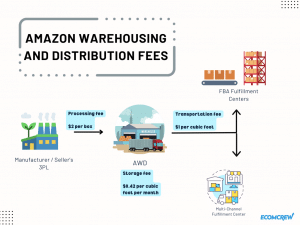
As of writing, AWD’s storage fee is the same throughout the year, even during peak season when seller fees are usually higher. This can change, however. For example, before the uniform pricing, Amazon used to charge the following:
| AWD Old Pricing | ||
|---|---|---|
| Until July 31, 2022 | From Aug 1, 2022 until the recent price change | |
| January to September | $0.62 per cubic foot per month | $0.42 per cubic foot per month |
| October to December | $1.20 per cubic foot per month | $0.80 per cubic foot per month |
Is it cheaper to use AWD? In general, yes. It’s definitely cheaper than FBA storage fees that are currently at $0.87 per cubic foot per month (from January to September) and $2.40 per cubic foot per month (from October to December). This is why it’s a welcome addition to Amazon’s logistics network as it allows sellers to store their inventory long-term for cheaper rates and automatically replenishes stocks as needed.
Now, let’s take a look at some real-world data from our own brand to determine how much you can actually save using AWD. Here are the differences between storage fees in AWD and FBA for four of our products.
As you can see, there is a significant difference between the two. It’s unsurprising though since fulfillment centers are not really designed for long-term storage. In fact, all FBA sellers should strive to just have enough inventory ready for buyers in the fulfillment centers. Others should be stored elsewhere.
But how does AWD compare with other 3PLs? The following table shows the storage and processing fees of some of the most popular 3PLs in the United States.
| Storage Fees | Pick and Pack Fees | Returns Processing | |
|---|---|---|---|
| ShipBob | $40 per pallet per month, $10 per shelf per month, $5 per bin per month | Pick and pack is free for the first four picks in an order, then $0.20 per pick for the fifth pick and after | $3 processing fee per returned order |
| ShipMonk | Bins: $1 to $4 per month, depending on the bin size | Depends on number of orders, but there’s a minimum of $250 per month | $2.00 + .50/additional item |
| Deliverr | Starts at $0.72 per cu. ft. per month | (Pick and pack fee is included in the fulfillment fee.) Starts at $3.99 per unit *This amount includes receiving, shipping, order handling, pick pack and package costs. | N/A |
| ShipHero | Starts at $0.65 per cubic foot **Charged daily per SKU based on the total cubic volume in stock | (Pick and pack fee is included in the fulfillment fee.) Starts at $5.29 *This amount includes receiving, order processing, picking the product, packing the order, the shipping box and postage. | Restocking Fee: $2.75 for first item and $0.25 for each additional item Inspection Fee: $3.45 per unit returned (apparel) / $2.95 per unit returned (non-apparel) Self Returns: $2.75 for first item and $0.25 for each additional item + inspection fee per unit (if applicable) Paid Label Fee: cost of return label Return to Sender: shipping label back, same cost it was to send out (if applicable) |
| FedEx | $8-$15 per pallet/month | Pick and pack: $0.40 per unit, including standard packing materials *Shipping rates are discounted FedEx rates | $2.50 per order |
They vary in pricing, but none of them are cheaper than what AWD is offering right now. This is why when the AWD program came out, it posed a threat to other 3PLs, especially for those who have many FBA sellers as clients.
How Do You Decide How Much Inventory to Send to AWD?
While AWD does offer lower storage fees, it’s still much cheaper to have just enough inventory sent to FBA fulfillment centers and not spend anything for long-term storage. So how do you strike the balance?
This is what we do in our own brands:
As a general rule, we keep 30 days’ worth of inventory in fulfillment centers and 60 days’ worth in AWD. The latter serves as a buffer for when we have a specially good month and sell more products than usual.
Meanwhile, we have two additional shipments on the water, each carrying a month’s worth of inventory and spaced enough to replenish stocks in time. It looks something like this:
The amount of inventory you send to any warehouse, of course, depends on the demand for the product. For our brands, we have a GSheet document that will tell us how long we can keep an inventory in AWD for it to still be profitable.
This sheet tells us how many months we can keep our products in AWD for us to break even and how much the AWD storage fees are compared to FBA. You can make a similar table like this to monitor your numbers.
The data we feed into this sheet are automatically pulled from Amazon so we don’t have to manually enter them. We discuss in detail how we make this sheet and other strategies we use to reduce our storage costs in EcomCrew Premium.

Final Thoughts
AWD seems like a win-win for both Amazon and its selling partners (not so much for other 3PLs). However, this is another way of making sellers more dependent on Amazon’s ecosystem, a la Apple.
This move also makes Amazon more powerful and may become another cause for stricter scrutiny by the Federal Trade Commission.
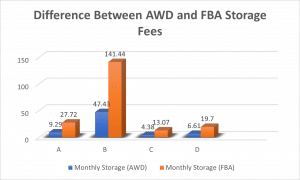
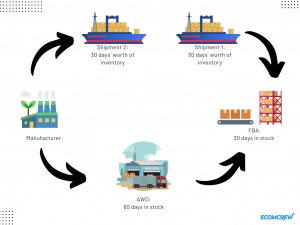
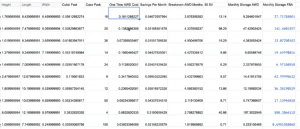




Great article. I am looking to ship one of my new products in AWD. Is palletization required for LTL? I have read mixed opinions.
No it’s not.
Interesting read. Obviously AWD is the way to go and rates have lowered this year. That is great for the manufacturers. Very well put together article. I really enjoyed looking at the graphs and the differences over time.
Glad you found it helpful, Ashley!
Great article EcomCrew team. Do you know if I can use the Amazon Warehousing & Distribution (AWD) program to send in *new* ASINs?
Or does it have to be an existing ASIN that I have already sold on Amazon, which will then be replenished when I’m about to go out of stock of that existing ASIN?
Scenario: I’m a private label seller who uses FBA. I regularly ship my products from China to USA using Amazon Global Logistics, and recently I started occasionally using AWD when I can’t ship directly into an FC due to Amazon’s restock limits. My supplier just finished producing an order of a *new* product I haven’t sold on Amazon before. Due to Amazon’s restock limits, I can’t create an FBA inbound shipment directly to an FC. If this were an existing ASIN that I have already been selling on Amazon, I would not hesitate to create an AWD shipment. But because this is a new ASIN, I’m unsure what will happen if I ship it to the US using AWD. It looks like I’m able to create an AWD shipment for this new ASIN, but I’m unsure what will happen when it gets to the Amazon AWD warehouse. Will it just sit there forever, and never be automatically be sent into an FC, because there is no going-out-of-stock trigger to do so given that it’s a new ASIN?
Thank you!
I believe it can be a new ASIN.